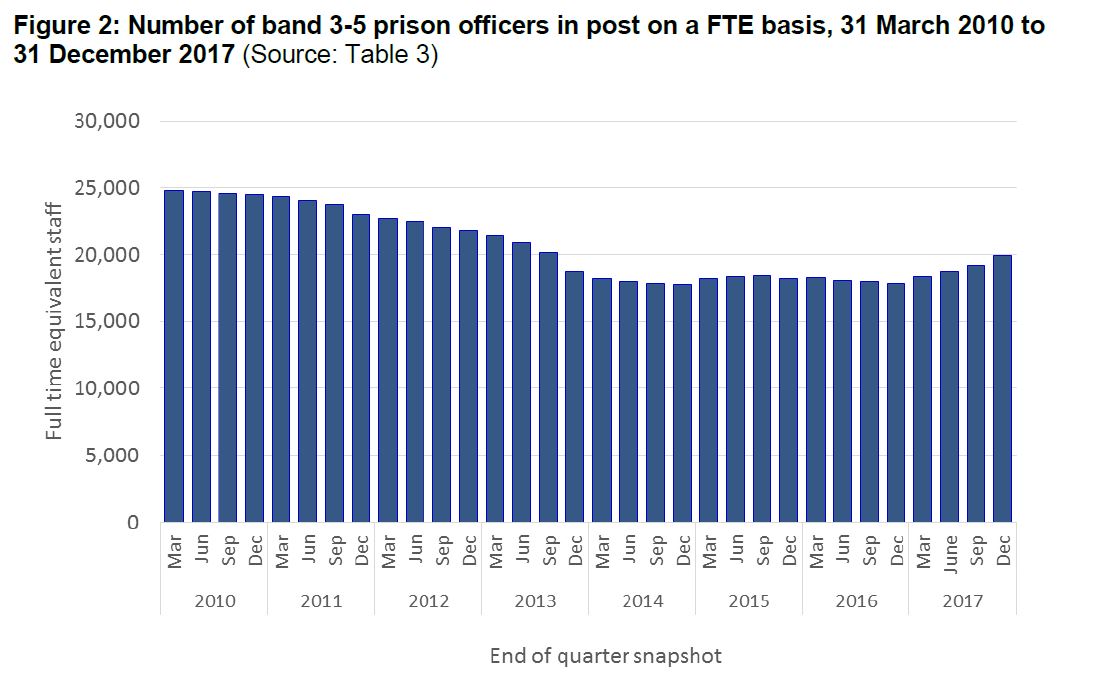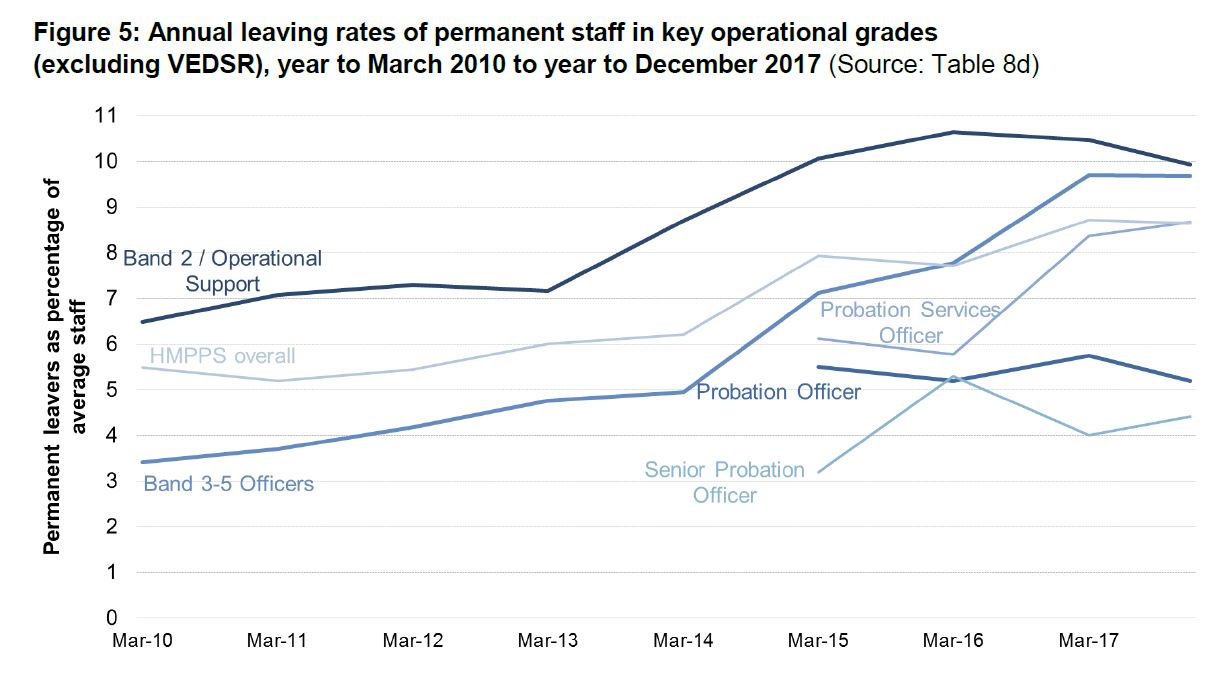Net increase of 715 in last quarter
Last week (15 February 2018), Her Majesty’s Prison and Probation Service published its latest Workforce Statistics Bulletin detailing staffing levels at 31 December 2017.
Overall the statistics are positive for a MoJ desperate to recruit frontline prison officers. Despite the leaving rate remaining high at nearly one in ten every year, there were 715 more prison officers in post on New Year’s Eve compared to three months earlier.
These are the headline findings:
- There were 19,925 FTE (full time equivalent) band 3-5 (frontline) prison officers in post – representing increases of 715 (3.7%) since 30 September 2017 and 2,038 (11.4%) compared to 31 December 2016. This is the highest number of officers in post since 30 September 2013.
- There were 4,363 FTE band 2 operational support staff in post – a decrease of 59 (1.3%) compared to the previous quarter and 250 (5.4%) against the previous year.
- There were 3,369 FTE band 4 probation officers in post – decreases of 65 (1.9%) over the quarter and 246 (6.8%) compared to the previous year. In contrast, there were 2,161 FTE band 3 probation services officers, an increase of 290 (15.5%) FTE over the quarter and 555 (34.6%) FTE over the past year.
- Band 3-5 prison officers continue to leave the service at the rate of 9.7% per year, the same figure as the year ending 31 March 2017.
Frontline prison officers
The key operational grades in public sector prisons are the band 3 to 5 prison officers. They consist of band 3 prison officers, band 4 officer specialists, band 4 supervising officers and band 5 custodial managers.
As at 31 December 2017, there were 19,925 FTE band 3 to 5 officers, the highest number of officers in post since 30 September 2013. Over the last year, 4,563 band 3 officers were appointed which represents an increase of 161.8% compared to the 12 months to 31 December 2016.
In contrast, the number of band 2 operational support group (OSG) FTE staff decreased by 59 (1.3%) compared to the previous quarter and by 250 (5.4%) against the previous year to stand at 4,363 at 31 December 2017. This is the lowest number of OSG staff in the time series.

The importance of prison officer recruitmetn becomes abundantly clear when you look at the chart below where you can see that there are still nearly 5,000 fewer frontline prison officers compared to March 2010.
National Probation Staff
Key grades in the NPS include band 3 probation services officers, band 4 probation officers (collectively known as probation practitioners) as well as band 5 senior probation officers.
At 31 December 2017, there were 2,161 FTE band 3 probation services officers in post, an increase of 290 (15.5%) on the quarter and 555 (34.6%) over the last year; 3,369 FTE band 4 probation officers, representing decreases of 65 (1.9%) over the quarter and 246 (6.8%) compared to the previous year; and 635 FTE band 5 senior probation officers, showing increases of 3 (0.5%) since the last quarter and 26 (4.2%) over the last year.
In the last year, 586 probation services officers were appointed, an increase of 103 compared to the year ending 30 September 2017 whilst 174 left, an increase of 10 compared to the same period. Once a probation services officer undertakes and obtains the Professional Qualification in Probation (PQiP), they are eligible to apply for a probation officer role. Meanwhile, 199 probation officers left over the last year, a decrease of 3 compared to the year ending 30 September 2017.
HMPPS does not keep workforce statistics for the 21 private Community Rehabilitation companies where there have been very sifniciant reductions in the number of staff since the Transforming Rehabilitation reforms.
Joiners and Leavers
In the last year, 6,663 staff joined HMPPS, an increase of 991 (17.5%) compared to the year ending 30 September 2017. These joiners consisted of 5,483 across Public Sector Prisons (PSPs), 960 in the NPS and 220 in HMPPS HQ and Area Services.
Compared to the year ending 30 September 2017, these represent increases of 17.4%, 24.0% and 3.1% respectively.
There were 4,062 leavers in the year ending 31 December 2017, a decrease of 79 (1.9%) compared to the year ending 30 September 2017. This includes 3,138 leavers from PSPs (a decrease of 2.1%), 688 from the NPS (a decrease of 0.1%) and 236 from HMPPS HQ and Area Services (a decrease of 4.5%).
However, leaving rates remained high among key staff.
For band 3 to 5 prison officers, the 9.7% leaving rate in the year ending 31 December 2017 represented no change compared to the year ending 31 March 2017. The leaving rate for band 2 OSG staff was 9.9% in the year ending 31 December 2017, a decrease of 0.6 percentage points to the year ending 31 March 2017.
The leaving rate for staff at the NPS overall in the year ending 31 December 2017 was 7.0%, a 0.3 percentage point decrease compared to the year ending 31 March 2017. In the operational grades within the NPS, the leaving rate was highest amongst probation service officers at 8.7%, increasing by 0.3 percentage points from the year ending 31 March 2017. In contrast, leaving rates for probation officers and senior probation officers stood at 5.2% and 4.4% in the year ending 31 December 2017.
Conclusion
It is heartening to see the MoJ make very real progress in recruiting new prison officers (even if it remains somewhat alarming to realise how low numbers had become).
However, in my opinion, we won’t know that there is real progress being made on staffing our prisons adequately and making them safer places to live and work again until the leaving rate starts going down substantially. The prison service needs its experienced staff now like never before.
On the probation front, it is also concerning that there were 6.8% band 4 probation officers compared to last year – is this one of the first concrete signs of the burn out that comes from working with a caseload consisting solely of high risk offenders?








